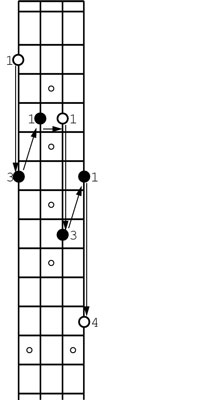When playing a two-octave arpeggio on bass guitar, you'll find that you can reach several of the notes without shifting your left hand. Even though the arpeggio has a lot fewer notes than the scale, playing it is more difficult (but not impossible). Because the notes of arpeggios are spread farther apart, arpeggios are perfect tools for practicing shifts.
You’re playing an arpeggio when you play chord tones in sequence (root, 3, 5, octave) one after the other in ascending or descending order.
Review the structure of the two-octave major arpeggio.

This is the structure of all the two-octave major arpeggios. Be sure to refer back to this structure while you’re playing. (If you happen to be a lefty, please read “right hand” to mean “left hand,” and vice versa.)
Press the index finger of your left hand down on any note on the E string.
Strike the string with your right hand to sound the note. This note is your root.
If you want to play an E major arpeggio, this isn't a fretted note; just play the open E string.
Shift your left hand by two frets along the E string toward the bridge. Press your ring finger (now four frets from the previous note) down on the E string.
When shifting your hand, aim with your index finger, but don’t press your index finger down on the fret! Strike the string with your right hand.
If you're playing an E major arpeggio, this doesn't involve a shift. Just play this second note with your ring finger and continue with the pattern.
Stay in position and move the index finger of your left hand across to the A string.
Press down with your index finger, and strike the string with your right hand.
Stay in position and move your index finger across to the D string.
Press down with your index finger and strike the string with your right hand. You’re now one octave above the original starting note.
Shift your left hand by two frets along the D string toward the bridge (aim with your index finger), and press your ring finger down on the D string.
Strike the string with your right hand.
Stay in position and move your index finger across to the G string.
Press down with your index finger and strike the string with your right hand.
Shift your left hand by two frets along the G string toward the bridge (aim with your index finger), and press your pinkie down on the G string.
Strike the string with your right hand. You’re now exactly two octaves above the original starting note from Step 2.
To descend this arpeggio, simply reverse the order and shift toward the nut of the bass.

